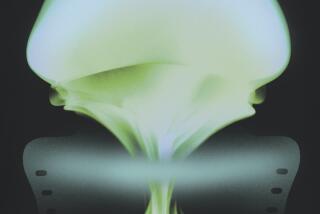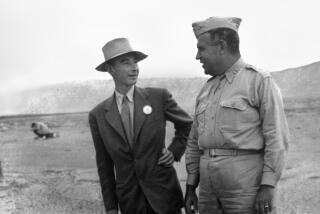THE GRIFFIN : Paul Rosbaud and the Nazi Atomic Bomb That Never Was by Arnold Kramish (Houghton Mifflin: $17.95; 281 pp.)
One November day in 1939, Harold Freese-Pennefather, a member of the British Legation in Oslo, was confronted by an unknown visitor who insisted that he take delivery of a small parcel. After a moment’s indecision, Freese-Pennefather took the package, and the stranger disappeared without leaving his name. When the package was opened, it was found to contain a book, something that looked rather like a radio valve, and a scientific report written in German. That report contained a mass of secret information about the German war effort, including information on two new radar systems and the first intimations of the work on rockets that had begun at the research station at Peenemunde.
This report, the so-called Oslo Report, was to be dismissed by the British as a hoax. It was to be more than three years before any action was taken to impede the work at Peenemunde, a delay that was to cost the British dearly.
As to the author of the report, he has remained anonymous, but in “The Griffin,” Arnold Kramish presents good circumstantial evidence that the author was the fascinating but shadowy Paul Rosbaud, a scientist and journalist who, throughout World War II, and at great personal risk, kept up a continuous supply of invaluable information on the German war effort flowing into Britain.
There is no doubt that Kramish has found a subject worthy of a biography. Rosbaud, illegitimate, an Austrian (his brother was the famous conductor Hans Rosbaud) was educated as a physicist but rapidly moved to a position of eminence in the world of scientific journalism. He was an Anglophile and also deeply worried by what the Nazis were doing in Germany. As consultant to the German scientific journal Naturwissenschaften, he ensured the publication of the discovery of nuclear “fission,” the process that showed that an atomic weapon was possible. As 1939 wore on, Rosbaud did his utmost to keep the channels of communication between scientists in various countries open. However, when war began and open contact became impossible, he went to great lengths to set up chains of agents, particularly in Scandinavia, to pass the information he had gleaned on to the British secret service. Throughout the war, he delivered a report almost monthly, each report containing numbers of pieces of information.
He had sent his Jewish wife and daughter to England early in the war, but he stayed on, narrowly missing arrest on several occasions. According to Kramish, it was largely because of Rosbaud that the British knew of the uncertain progress and eventual failure of the German atomic weapon program as it happened, and this leads Kramish to claim that he can now demolish a major myth of our time. That is that the Germans and the Allies were locked into a race to build a bomb when, in fact, no such race existed.
Certainly he shows that after a promising start, the German program ground to a halt in mid-1942. However, this is well known and has been the subject of several books. He then goes on to indicate that while the British knew of this failure from “The Griffin”--Rosbaud’s code name--the Americans did not. He shows that by the summer of 1943, British intelligence was stating that the German bomb program “was ceasing to be a source of grave anxiety.” Yet, by this time, the Americans had already turned their attention toward Japan. Whether they knew about the Griffin’s reports or not, in the spring of 1943, the American Military Policy Committee had discussed the Japanese fleet at Truk as a possible target for the new weapon. Even at this early stage, they had developed their own motives for the bomb project other than the race against Germany. There was in fact no simple race of the kind whose existence the author wants to disprove.
This is not the only incidence of shadow boxing in the book. The author also seeks to correct another possible misconception about what happened at a meeting in 1941 between Werner Heisenberg, a leading German atomic physicist, and the revered Danish physicist, Neils Bohr. According to Kramish, supporters of Heisenberg have tried to spread the notion that he came to Bohr to ask him to use his good offices to persuade the physicists of the world not to work on the bomb. In fact, Kramish says, Heisenberg went to pick Bohr’s brains for information on the American bomb program. Again, I would not quarrel with this conclusion, only with the author’s belief that this is not already well known.
But these and the other quixotic endeavors in this book would count for little if the biography itself worked well. Certainly the author has accomplished a mammoth task in knitting together material from 500 interviews and more than 100 archival sources, and he has succeeded in creating an intricate and sometimes fascinating picture of intelligence activities inside Germany and the occupied countries during the war. As a biography, however, his book is much less successful. For much of this time, Rosbaud lived the covert life of the spy, and the author has obviously had a difficult job piecing together this aspect of his life. However, he did have access to a number of people who knew Rosbaud well, and yet their views have not been made to serve, as they might have, to weld the other material into a whole. I have no lasting impression of Rosbaud as a character. Further, the overall fragmented feel is not helped by the structure. Why, for instance, is an intriguing chapter on Rosbaud’s technique as a spy, which could have colored the reading of earlier chapters, left to the end?
Kramish has exposed to public view a remarkable man, and I am grateful to him for all the effort that has made this possible. I only wish that his labors could have produced a better book.
More to Read
Sign up for Essential California
The most important California stories and recommendations in your inbox every morning.
You may occasionally receive promotional content from the Los Angeles Times.










